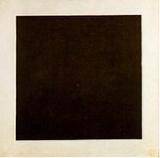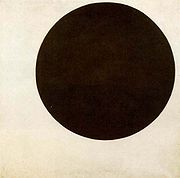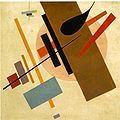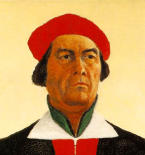
Suprematism
Encyclopedia


Kazimir Malevich
Kazimir Severinovich Malevich was a Russian painter and art theoretician, born of ethnic Polish parents. He was a pioneer of geometric abstract art and the originator of the Avant-garde Suprematist movement.-Early life:...
.
Establishment
Kasimir Malevich originated Suprematism in 1915 when he was an established painter having exhibited in the Donkey's TailDonkey's Tail
Donkey's Tail was a Russian artistic group created from the most radical members of the Jack of Diamonds group. The group included such painters as: Mikhail Larionov , Natalia Gontcharova, Kazimir Malevich, Marc Chagall, and Alexander Shevchenko. The group was influenced by the Cubo-Futurism...
and the Der Blaue Reiter
Der Blaue Reiter
Der Blaue Reiter was a group of artists from the Neue Künstlervereinigung München in Munich, Germany. The group was founded by a number of Russian emigrants, including Wassily Kandinsky, Alexej von Jawlensky, Marianne von Werefkin, and native German artists, such as Franz Marc, August Macke and...
(The Blue Rider) exhibitions of 1912 with cubo-futurist
Cubo-Futurism
Cubo-Futurism was the main school of painting and sculpture practiced by the Russian Futurists.When Aristarkh Lentulov returned from Paris in 1913 and exhibited his works in Moscow, the Russian Futurist painters adopted the forms of Cubism and combined them with the Italian Futurists'...
works. The proliferation of new artistic forms in painting, poetry and theatre as well as a revival of interest in the traditional folk art
Folk art
Folk art encompasses art produced from an indigenous culture or by peasants or other laboring tradespeople. In contrast to fine art, folk art is primarily utilitarian and decorative rather than purely aesthetic....
of Russia provided a rich environment in which a Modernist
Modernism
Modernism, in its broadest definition, is modern thought, character, or practice. More specifically, the term describes the modernist movement, its set of cultural tendencies and array of associated cultural movements, originally arising from wide-scale and far-reaching changes to Western society...
culture was born.
In his book The Non-Objective World, which was published abroad as a Bauhaus
Bauhaus
', commonly known simply as Bauhaus, was a school in Germany that combined crafts and the fine arts, and was famous for the approach to design that it publicized and taught. It operated from 1919 to 1933. At that time the German term stood for "School of Building".The Bauhaus school was founded by...
Book in 1927, Malevich described the inspiration which brought about the powerful image of the black square on a white ground:
- I felt only night within me and it was then that I conceived the new art, which I called Suprematism.
He created a suprematist 'grammar' based on fundamental geometric forms; in particular, the square and the circle. In the 0.10 Exhibition in 1915, Malevich exhibited his early experiments in suprematist painting. The centerpiece of his show was the Black Square, placed in what is called the red/beautiful corner in Russian Orthodox tradition ; the place of the main icon in a house. "Black Square" was painted in 1915 and was presented as a breakthrough in his career and in art in general. Malevich also painted White on White which was also heralded as a milestone. "White on White" was a breakthrough from polychrome to monochrome
Monochrome
Monochrome describes paintings, drawings, design, or photographs in one color or shades of one color. A monochromatic object or image has colors in shades of limited colors or hues. Images using only shades of grey are called grayscale or black-and-white...
Suprematism.
Influences on the movement
Malevich also credited the birth of suprematism to Victory Over the SunVictory over the Sun
Victory over the Sun is a Russian Futurist opera premiered in 1913 at the Luna Park in Saint Petersburg.The libretto written in zaum language was contributed by Aleksei Kruchonykh, the music was written by Mikhail Matyushin, the prologue was added by Velimir Khlebnikov, and the stage designer was...
, Kruchenykh
Aleksei Kruchenykh
Aleksei Eliseevich Kruchenykh or Kruchonykh or Kruchyonykh , a well-known poet of the Russian "Silver Age", was perhaps the most radical poet of Russian Futurism, a movement that included Vladimir Mayakovsky, David Burliuk and others. Together with Velimir Khlebnikov, Kruchenykh is considered the...
's Futurist
Russian Futurism
Russian Futurism is the term used to denote a group of Russian poets and artists who adopted the principles of Filippo Marinetti's "Manifesto of Futurism"...
opera production for which he designed the sets and costumes in 1913. One of the drawings for the backcloth shows a black square divided diagonally into a black and a white triangle. Because of the simplicity of these basic forms they were able to signify a new beginning.
Another important influence on Malevich were the ideas of the Russian mystic-mathematician, philosopher, and disciple of Georges Gurdjieff; P. D. Ouspensky
P. D. Ouspensky
Peter D. Ouspensky , , a Russian esotericist known for his expositions of the early work of the Greek-Armenian teacher of esoteric doctrine George Gurdjieff, whom he met in Moscow in 1915.He was associated with the ideas and practices originating with...
who wrote of "a fourth dimension or a Fourth Way
Fourth Way (book)
The Fourth Way is a book about the Fourth Way system of self-development as introduced by Greek-Armenian philosopher G.I. Gurdjieff and is a compilation of the lectures of P. D. Ouspensky at London and New York, 1921-1946, published posthumously by his students in 1957...
beyond the three to which our ordinary senses have access".

Association
The SupremusSupremus
Supremus was a group of Russian avant-garde artists led by the "father" of Suprematism, Kazimir Malevich. It included Aleksandra Ekster, Liubov Popova, Olga Rozanova, Ivan Kliun, Ivan Puni, Nadezhda Udaltsova, Nina Genke-Meller, Ksenia Boguslavskaya and others.-See also:*Suprematism*Kazimir...
group, which in addition to Malevich included Aleksandra Ekster
Aleksandra Ekster
Aleksandra Aleksandrovna Ekster was a Russian-French painter and designer.-Biography:-Childhood:...
, Olga Rozanova
Olga Rozanova
Olga Vladimirovna Rozanova Olga Vladimirovna Rozanova Olga Vladimirovna Rozanova (also spelled Rosanova, Russian: (Ольга Владимировна Розанова) (1886-7 November 1918, Moscow) was a Russian avant-garde artist in the styles of Suprematist, Neo-Primitivist, and Cubo-Futurist.-Biography:...
, Nadezhda Udaltsova
Nadezhda Udaltsova
Nadezhda Andreeva Udaltsova was a Russian avant-garde artist and painter.-Biography:Nadezhda Udaltsova was born in town Orel in Russia. Udaltsova studied at private art studios in Moscow, then in Paris under André Segonzac....
, Ivan Kliun
Ivan Kliun
Ivan Kliun was a Russian painter, Avant-garde artist , graphic artist and sculptor.-Biography:Ivan Vasilyevich Kliun was born in 1873 in Bolshie Gorki village ....
, Liubov Popova, Nikolai Suetin
Nikolai Suetin
Nikolai Suetin was a Russian Suprematist artist. He worked as a graphic artist, a designer, and a ceramics painter.Suetin studied at the High Institute of Art, Vitebsk under Kazimir Malevich, founder of Suprematism, an early abstract art movement which developed a style based on 'non objective'...
, Ilya Chashnik
Ilya Chashnik
Ilya Grigorevich Chashnik was a suprematist artist, a pupil of Kazimir Malevich and a founding member of the UNOVIS school.Chashnik was notably able in a variety of media...
, Nina Genke-Meller
Nina Genke-Meller
Nina Genke or Nina Genke-Meller, or Nina Henke-Meller, was a Ukrainian-Russian avant-garde artist, , designer, graphic artist and scenographer. -Biography:...
, Ivan Puni
Ivan Puni
Ivan Puni or Puny was a Russian avant-garde artist .-Biography:Ivan Puni was born in Kuokkala to a family of Italian origins...
and Ksenia Boguslavskaya
Ksenia Boguslavskaya
Kseniya Boguslavskaya was a Russian avant-garde artist poet and interior decorator. Her husband Ivan Puni was also a notable painter...
, met from 1915 onwards to discuss the philosophy of Suprematism and its development into other areas of intellectual life. There was some crossover with Constructivism
Constructivism (art)
Constructivism was an artistic and architectural philosophy that originated in Russia beginning in 1919, which was a rejection of the idea of autonomous art. The movement was in favour of art as a practice for social purposes. Constructivism had a great effect on modern art movements of the 20th...
, with Suprematists such as Popova and especially El Lissitzky
El Lissitzky
, better known as El Lissitzky , was a Russian artist, designer, photographer, typographer, polemicist and architect. He was an important figure of the Russian avant garde, helping develop suprematism with his mentor, Kazimir Malevich, and designing numerous exhibition displays and propaganda works...
working on propaganda
Propaganda
Propaganda is a form of communication that is aimed at influencing the attitude of a community toward some cause or position so as to benefit oneself or one's group....
and industrial design
Industrial design
Industrial design is the use of a combination of applied art and applied science to improve the aesthetics, ergonomics, and usability of a product, but it may also be used to improve the product's marketability and production...
.
Lissitzky spread Suprematist ideas abroad in the early 1920s.
Architecture
Nikolai Suetin used Suprematist motifs on works at the St. Petersburg Lomonosov Porcelain Factory where Malevich and Chashnik were also employed, and Malevich designed a Suprematist teapot. The Suprematists also made architectural models in the 1920s which offered a different conception of socialist buildings to those developed in Constructivist architectureConstructivist architecture
Constructivist architecture was a form of modern architecture that flourished in the Soviet Union in the 1920s and early 1930s. It combined advanced technology and engineering with an avowedly Communist social purpose. Although it was divided into several competing factions, the movement produced...
.
Malevich's architectural projects were known after 1922 Arkhitektoniki. Designs emphasized the right angle
Right angle
In geometry and trigonometry, a right angle is an angle that bisects the angle formed by two halves of a straight line. More precisely, if a ray is placed so that its endpoint is on a line and the adjacent angles are equal, then they are right angles...
, with similarities to De Stijl
De Stijl
De Stijl , propagating the group's theories. Next to van Doesburg, the group's principal members were the painters Piet Mondrian , Vilmos Huszár , and Bart van der Leck , and the architects Gerrit Rietveld , Robert van 't Hoff , and J.J.P. Oud...
and Le Corbusier
Le Corbusier
Charles-Édouard Jeanneret, better known as Le Corbusier , was a Swiss-born French architect, designer, urbanist, writer and painter, famous for being one of the pioneers of what now is called modern architecture. He was born in Switzerland and became a French citizen in 1930...
, and were justified with an ideological connection to communist governance and equality for all. Another part of the formalism
Formalism (art)
In art theory, formalism is the concept that a work's artistic value is entirely determined by its form--the way it is made, its purely visual aspects, and its medium. Formalism emphasizes compositional elements such as color, line, shape and texture rather than realism, context, and content...
was low regard for triangles which were "dismissed as Ancient, pagan, or Christian
Christian
A Christian is a person who adheres to Christianity, an Abrahamic, monotheistic religion based on the life and teachings of Jesus of Nazareth as recorded in the Canonical gospels and the letters of the New Testament...
".
Social context

Stalinism
Stalinism refers to the ideology that Joseph Stalin conceived and implemented in the Soviet Union, and is generally considered a branch of Marxist–Leninist ideology but considered by some historians to be a significant deviation from this philosophy...
took hold from 1924 on, the state began limiting the freedom of artists. From the late 1920s the Russian avant-garde
Russian avant-garde
The Russian avant-garde is an umbrella term used to define the large, influential wave of modern art that flourished in Russia approximately 1890 to 1930 - although some place its beginning as early as 1850 and its end as late as 1960...
experienced direct and harsh criticism from the authorities and in 1934 the doctrine of Socialist Realism
Socialist realism
Socialist realism is a style of realistic art which was developed in the Soviet Union and became a dominant style in other communist countries. Socialist realism is a teleologically-oriented style having its purpose the furtherance of the goals of socialism and communism...
became official policy, and prohibited abstraction and divergence of artistic expression. Malevich nevertheless retained his main conception. In his self-portrait
Self-portrait
A self-portrait is a representation of an artist, drawn, painted, photographed, or sculpted by the artist. Although self-portraits have been made by artists since the earliest times, it is not until the Early Renaissance in the mid 15th century that artists can be frequently identified depicting...
of 1933 he represented himself in a traditional way — the only way permitted by Stalinist cultural policy — but signed the picture with a tiny black-over-white square.
Sources
- Kasimir Malevich, The Non-objective World. English translation, Paul Theobald and Company, 1959
- Camilla Gray, The Russian Experiment in Art, Thames and Hudson, 1976
- Mel Gooding, Abstract Art, Tate PublishingTate Publishing LtdTate Publishing is a publisher of visual arts books, associated with the Tate Gallery in London, England. It was established in 1911; nowadays it is a division of Tate Enterprises Ltd, an independent company wholly owned by the Trustees of Tate, and is based at Tate Britain, Millbank, London...
, 2001

